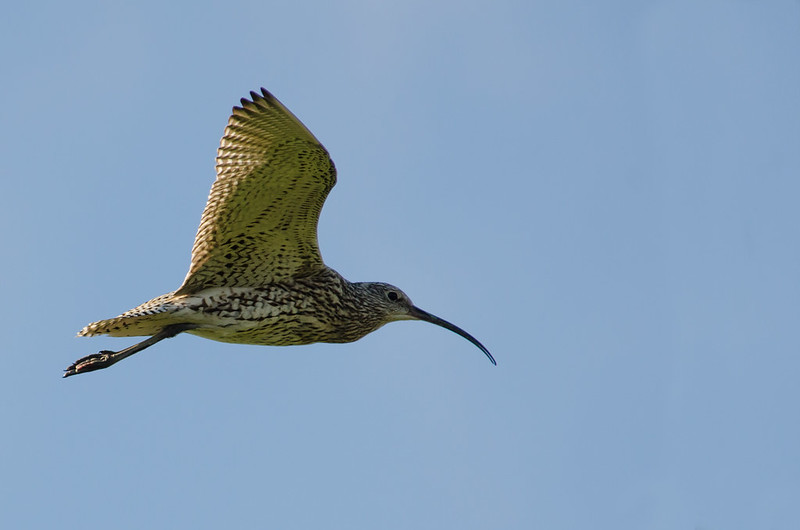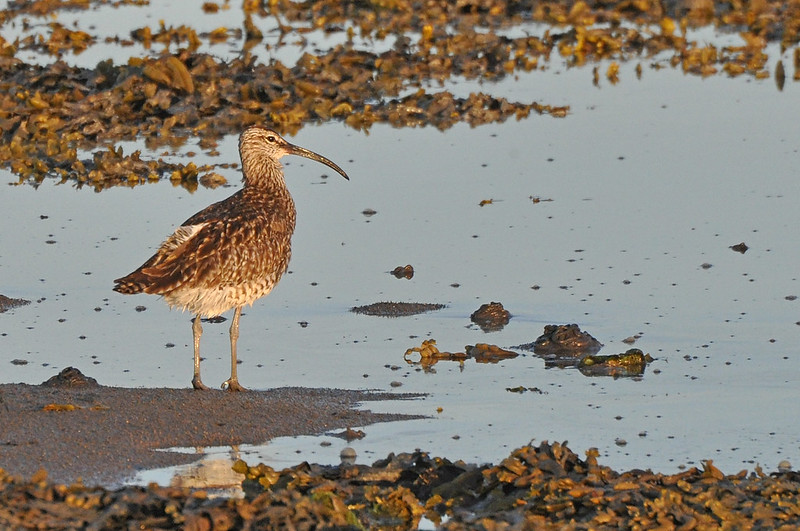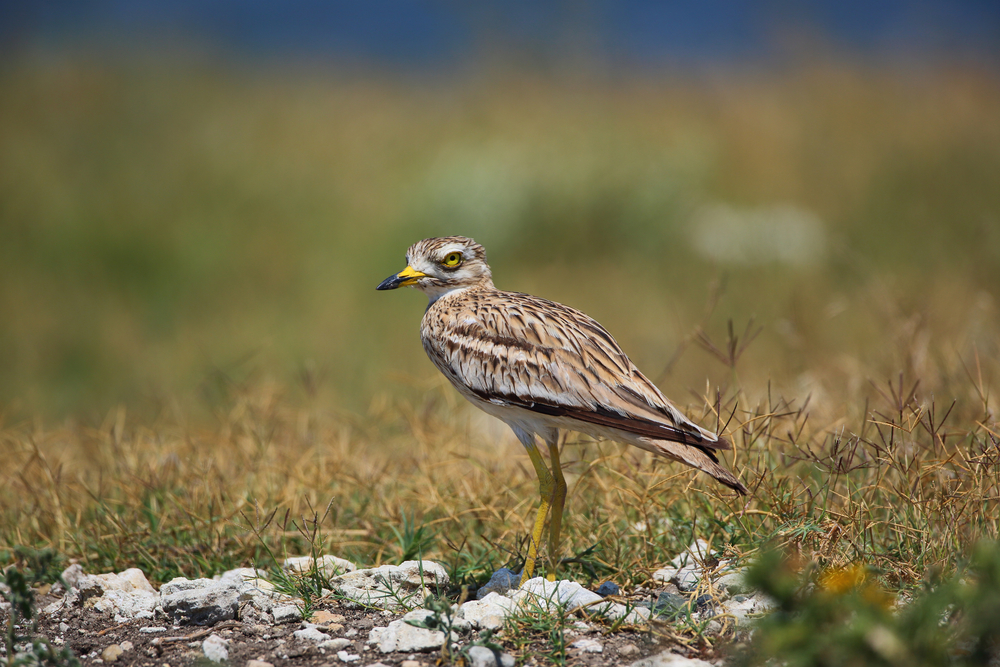
Curlews are pretty spectacular birds: large with amazing bills and a loud bubbling song. Once common in grasslands, wetlands and uplands across the UK they are now rare as breeders outside of the uplands. There is a pair of Curlew in the Nene Valley about six miles from my home, and I occasionally go to have a look for them from afar. They’re difficult to spot and even when I have been lucky I haven’t heard this song in my adopted county, yet.
Here is a sound you are much more likely to hear in the hills. This one from Sweden:
…and another from Finland;
…and this from Northumberland, UK:
Very bubbly aren’t they? It’s a wonderful song, and you’d think there isn’t anything like it, and for most of us in the UK there isn’t, but there are a couple of species that are quite similar.
First is the Whimbrel – a smaller version of the Curlew which breeds in Iceland, Alaska, northern Scandinavia and in Shetland in the UK. It looks pretty much like a Curlew and sounds very much like a Curlew:

Whimbrels end with long series of repeated notes just to make you think ‘Not as good as a real Curlew’.
And then there is the Stone Curlew (not a close relative at all) which sounds like a strangled Curlew;

But for most of us, in most parts of the UK, if we hear ‘cooor-lii’ it’s a Curlew.
[registration_form]
I find it a most evocative and musical bird call. When I visit my parents Bangor I love to go to the pier and hear them out on the mudflats of Traeth Lafan.
Tomorrow, 21 April, is World Curlew Day, part of the effort to highlight the terrible decline in this species. Attempts are being made in a local AONB in south Shropshire to work with farmers to provide suitable breeding habits, see https://curlewcountry.org
We will probably be a loggerheads but here we go.
Where I live in Yorkshire most Curlews occupy moorland, fields and/or by- land contiguous thereto. (Along with the Lapwing and other red and amber listed birds)
The moors are SSSI,s, and the fields or by- lands in the main SPA,s.
Given grazing agreements to protect the SSSI , most lambing takes place on the land designated as SPA,s.
The Carrion crows are a significant factor in nest failures. I have watched there ‘relentlessly ‘mobbing of nests and nestlings over a number of years. They also take advantage of yews in difficulty or new born lambs.
We cannot secure a General Licence to control the crows activities which flys in the face of all common sense because of the habitat designation.
So the farmer suffers losses and it will not be long before there will be no returning curlew (or Lapwing).
European law requires three areas of additional qualification in justifying the exercise of any domestic legislation. No doubt they have featured in your consultations with your lawyers per Wild Justice.
They are; Is there a law which permits some action on your part to address the damage or wrong.
Is any action on your part Necessary
and lastly is it Proportionate.
I believe all three areas are met and particularly when twinned with licences limited to the Spring and early Summer.
NE are not currently issuing specific General Licences for land forming SSSI,s or SPA,s.
The very habitats which our vulnerable Curlew and other birds – yes including Red and Black Grouse occupy.
They have very little chance of achieving a successful nest and future generations.
Like the South of England will we soon cease to hear the iconic call because all common sense fails to prevail?.
Respectfully
Phillip Walker
‘We cannot secure a General Licence to control the crows’
###
Can you not apply for a specific licence?
It’s all bollocks Phillip, they would rather you cut down a fifty year old tree to stop the crows perching in it.
‘Give a small boy a hammer, and he will find that everything he encounters needs pounding.’
Abraham Kaplan
Applies just as well to shooters and guns.
Phillip….are the crows not part of the same ecosystem as the curlews and red grouse etc.? What role do the crows play in that ecosystem?
Remember they are there 365 days a year, their interaction with eggs and chicks only happens over a couple of weeks. How do they survive the reset of the year?
Philip -thanks for your comment. I doubt that you and I will fall out about this although we may see things differently.
First, just for clarification, the moorlands are in the SPAs (and probably SACs) as well as the fields – you give me the impression that they aren’t but they almost certainly will be. You can check on the MAGIC system which you can find by googling JNCC Magic.
Wild Justice has never objected to general licences for the purpose of protecting livestock or crops from serious damage.
Carrion Crows are a significant factor in nest failure – we don’t disagree about that. And that is why Wild Justice never asked for the general licences to be revoked (that was a NE decision) and we have never called for Carrion Crow to be fully protected or to be taken off (new, better and different) general licences. So there isn’t a lot for you and me to fall out about there.
However, Red Foxes are a far more important predator of Curlew than are Carrion Crows – that’s what the science says and just because foxes do it in the dark doesn’t mean they don’t do it. So, a focus on Carrion Crow alone would be very misplaced (you didn’t suggest that, but I am just pointing it out).
And another ‘however’ is that general licences are not focussed on places where Curlew live – they allegedly allow killing of Carrion Crows anywhere in the country for various purposes. Maybe if they were more restricted in scope and use then they wouldn’t attract so much attention – just saying?
And yet another ‘however’ is that the UK has very high numbers of Carrion Crows and Red Foxes compared with other countries – there are a variety of reasons for that but it clearly isn’t some inability over many decades to bump off these species because that has been entirely legal all this time (albeit through licences that NE conceeded were themselves illegal).
I think you have the law a bit wrong but not in a way that really matters – and since neither of us is a lawyer then a discussion about that here would be a bit pointless.
NE has the power to issue specifric licences for control of Carrion Crow on SSSIs/SPAs/SACs and I thought they were – you tell me they aren’t. That’s interesting but if so, I can’t explain that. Are you saying that you have applied for licences and been turned down?
Are we at loggerheads? I hope not.
Interesting to note that today the gamekeepers celebrating national curlew day are reporting on finding nests with eggs….
North Pennines moorland group.
What are these keepers doing? Clearly …not what the law requires.
[note – please ignore this comment if my first one came through, but i fear I deleted it!].
Thank you for sharing these, Mr Avery, and for the work you do. I wanted to write though as I believe this post is touching on a real problem here which we now face, which has already been picked up by two of your previous commentators. We are all on the same side here but we must be honest with ourselves otherwise we risk losing all trust and making all enthusiasts of ornithology look like fools.
I think we can all agree our shared love for these curlews. Seeing them gives pleasure to everyone from the most experienced enthusiast to a young child out for the first time. But I cannot help but raise the issue that surely the impact of the stance you are taking at Wild Justice with the General Licenses risks threatening the existence of these very birds that you are now celebrating.
We all know clearly, whether we choose to admit it or not, that by far the greatest threat they face is predation from crows, foxes, guls etc. Whatever our opinions of shooters is, I see clearly their value in protecting rare birds by controlling predators accordingly. Whether that is their intended consequence or just a fortuitous side-effect I don’t know nor do I frankly care as long as these birds are protected. Now I cannot open a newspaper without hearing about people in uproar because of an inability to control predators because of the General Licenses and I fear the actions of Wild Justice – intended or not – risks undermining all of us who care so much about curlews.
I see you have responded to Mr Phillip Walker that your position should not impact people’s ability to control predators as required, but if they are not being given a license to do so whatever the reason, then it is these curlews that are paying the price and all of us are poorer for it as a result.
If you have not yet seen it I encourage everyone to look at this research carried out on curlews in East Anglia: https://wadertales.wordpress.com/2020/02/24/curlews-and-foxes-in-east-anglia/
It is clear that unless there is proper predation management then we will lose curlews, all genuine ornithologists recognise that. Surely we should be focusing our attention on this rather than risking their future?
I have huge respect for the work that you do Mr Avery however on this I really feel you are wrong. I would welcome your thoughts.
Respectfully yours,
Mr Degu Said
Degu Said – the general licences don’t cover foxes or other mammals so let’s not confuse the point. And neither I nor Wild Justice has argued that predator control should stop, merely that it ought to be lawful and properly regulated, so let’s not confuse the issue again. We don’t all know that ‘by far the greatest threat they face is predation from crows, foxes, guls etc’ since other factors such as the switch to silage from haymaking will have been very important too, however, since control of foxes and crows has been legal for decades and still is legal then I’m not quite sure what point you are trying to make.
Do you have personal experience of NE’s operation of the licensing system these days? I don’t. It’s a bit difficult to comment on what they are doing without that personal experience. Please let us all know whether you have had that experience, thanks.
Mark. Thank you for your reply. I appreciate your point in respect of the SPA,s and the SAC,s , along with the SSSI,s sometimes having dual status and yes I am aware of the MAGIC system which identifies the designations
I am afraid the Licencing Authority are being very difficult where one makes an application where it falls into one of the above. I have seen some licences which have been granted which despite the amended application have been returned still prohibiting a licence covering the SSSI / SPA etc which is baffling.
This is no doubt due to NE conceding Wild Justice May have had a point when it saw the GL as little more than an unregulated rubber stamp to control crows, magpies pigeons etc by whoever.
They clearly now require two of the elements I referred to necessity and proportionality – but please see my later dribble.
I appreciate your point on foxes, but my focus is of course on the Carrion Crow. It may interest you to know every year I see pairs of magpies predating the nests of curlew and Lapwings and in every witnessed case at fledgling stage. I appreciate I am going slightly off course so I will return to your narrative.
One of the reasons I believe there are lots of red foxes and Carrion crows is that both have adapted their lifestyles to modern society- where and how we live etc, and of course any attempt to control their number is on the scale of things – relatively small given their unrestricted range.
They are of course in the main controlled where the land is farmed, shot over and in smaller instances where conservation bodies see their control as a necessity.
I have often thought long and hard about your point that for example releasing and feeding large numbers of game birds may encourage them, but of course there are large but a lot of small shoots as well.
My point on the three principles of lawful action, necessity and proportionality does underpin how the courts and others exercise for example the prosecution of offences, any covert action in detecting such offences and lawyers in making representations to the courts where parties are prosecuted.
Since the European Convention of Human Rights was adopted by Mr Blair’s government in October 2000, these principals and the individual Articles – Right to life – Privacy etc etc should be considered by the courts and prosecuting authorities . They also extend to any body considering the granting of a Licence for example covert surveillance etc. I am really getting off the subject now !.
Finally, yes NE are turning down licences for controlling c/ Crows for example on those designated areas highlighted.
My point is simply where you can show legislation is in place to grant licences for such areas, necessity is shown and you can show this and proportionality in what /how you intend to control for example the C/ Crow that licence ought to be granted.
I am glad we are not a loggerheads, and still hope so given my ranting here.
Respectfully
Phillip W
Phillip Walker
Have you applied for a specific licence to kill carrion crows to protect curlew?
No need for a lengthy response
Philip – we are certainly not at loggerheads but you have been a little vague of foxes. Are you killing them or not? Because they are a more important threat to Curlews etc than are Carrion Crows as I read the science. And of course they have adapted to modern society but the fact remains that we have very high densitites of crowes and foxes in our modern society, despiting a free for all in killing them, compared with other countries. We need a more fundamental look at this issue than licensed killing with little control or regulation.
But neither I nor Wild Justice has asked for Carrion Crow to be fully protected so we aren’t at loggerheads.
I’m interested in what you say is Natural England’s attitude to licensing. You make what appear to be good points but I’d be interested to hear NE’s response and I guess we never will.
de o d.
No but I take your point. Our application was general – focused on red and amber listed birds -which correlated with the particular SPA.. Thank you. Phillip W
Mark. Yes foxes are controlled and I agree they have a significant impact. ..
Best.
Phillip W